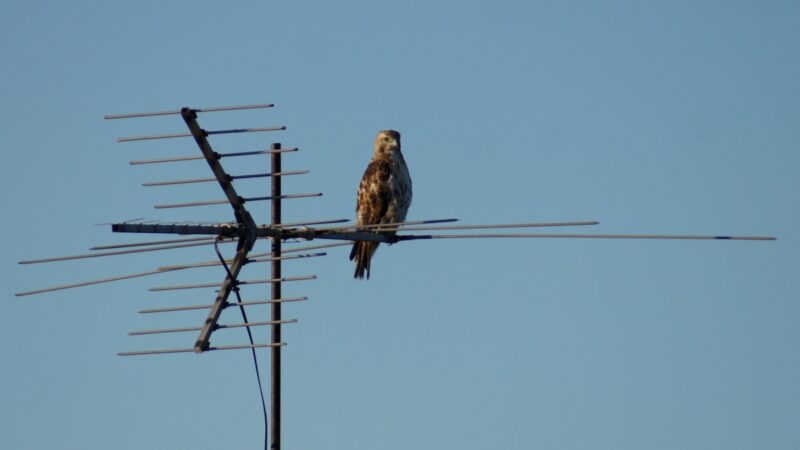6 Best Backpacking Tents for 2024
As spring approaches, nature lovers start to gear up for backpacking adventures. But without the right gear, enjoying the great outdoors to the fullest can be challenging.
Videos by Outdoors
Have you ever set out on a backpacking trip and had the heaviest tent of all time, had condensation soaking your sleeping bag, or prayed to the universe to stop the rain soaking through your tent on a cold night on the trail?
If your current tent doesn’t meet your needs or is showing signs of wear, it may be time for an upgrade.
The best overall choice for backpacking tents is the REI Half Dome SL 2+. While it may not be the lightest, it’s very light for a tent, is durable, has a great price point, and is the most bang for your buck.
In addition to the Half Dome SL 2+, our selection features a range of backpacking tents, from lightweight options for solo backpackers to expedition-style tents or those built for comfort. Read on to discover our picks for the best backpacking tents, and make 2024 your best backpacking year yet.
6 Best Backpacking Tents
Best Overall: REI Half Dome SL 2+
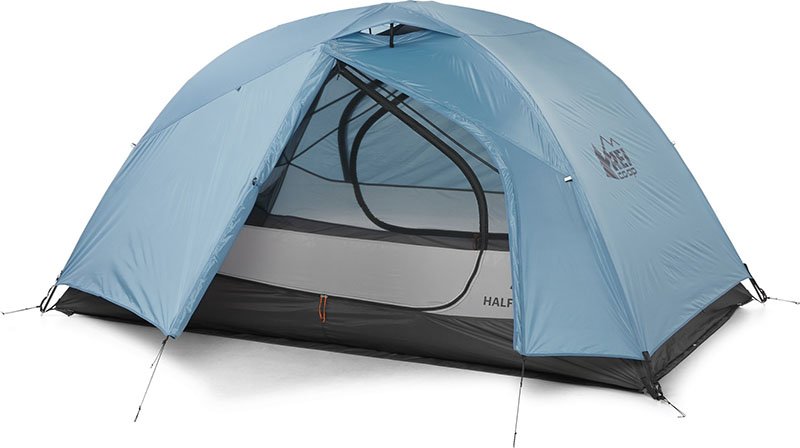
The REI Co-op Half Dome SL 2+ tent has a compelling combination of features, quality, weight, and price that sets it apart in the backpacking tent market. This tent remains a favorite among camping tents due to its spacious interior, and durability. Plus, it’s a great value for the money.
The tent is generous and offers a very long length and generous peak height, so taller folks will be comfortable too.
The Half Dome SL 2+ excels in providing ample interior space, with a floor area of 33.7 square feet, making it larger than many other ultralight tents. The near-vertical mesh side walls further make it feel extra spacious.
While the tent prioritizes interior space and durability over weight, it still manages to weigh only three pounds. Trimming away the footprint reduces the weight.
The tent has quality components, like the DAC aluminum pole system, upgraded stakes, a robust 40-denier floor, and a 30-denier rainfly.
This ultralight backpacking tent has a full-coverage rainfly and a raised bathtub floor. While it performs well in rain and light wind, its tall profile may make it susceptible to bowing in high winds. Packing extra stakes for guying out the tent can help.
With two doors and vestibules, the tent provides plenty of storage space for gear on both sides, unlike many backpacking tents. It features large vents and mesh panels for efficient ventilation, minimizing condensation on humid nights.
The freestanding design and one-piece hubbed pole system make setting up and taking down the tent easy, even for beginners.
While it may not be the lightest option available, its combination of features makes it a top contender.
Specs:
- Seasons: 3-season
- Sleeping Capacity: 2-person
- Minimum Trail Weight: 3 lbs. 15 oz.
- Packaged Weight: 4 lbs. 11.5 oz.
- Packed Size: 7 x 20.5 inches
- Floor Dimensions: 90 x 54 inches
- Peak Height: 42 inches
Best for Living Space: Big Agnes Copper Spur HV UL2 Tent
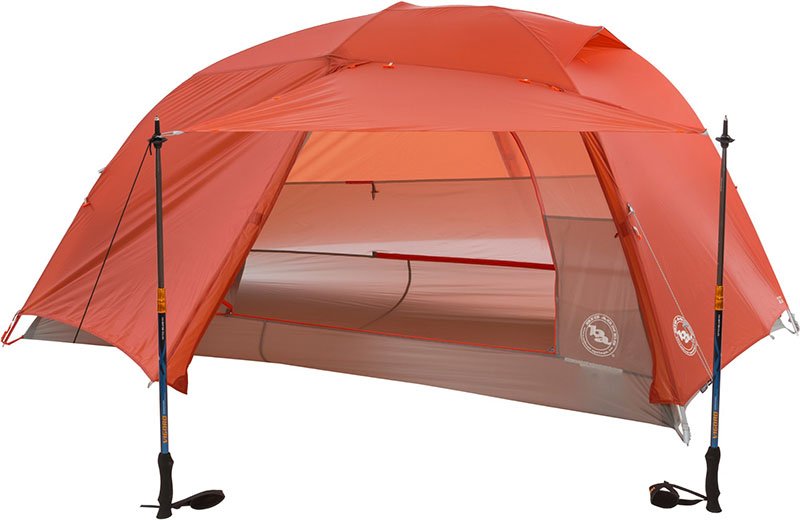
The Big Agnes Copper Spur HV UL2 is a great lightweight tent for those seeking space and comfort without compromising on weight, with features like two large doors and vestibules. This freestanding tent is also easy to set up, making it suitable for both short weekend trips and longer expeditions.
The Big Agnes Copper Spur HV UL2 has large side door vestibules, plus plenty of headroom so two people can sleep well on the floor space, with room for gear.
It’s lightweight for a roomy tent, with the minimal trail weight being about two pounds. Its peak height is a generous 40 inches. There are ceiling pockets, media pockets, and off-the-floor storage.
It’s spacious and has good headroom, but potential drawbacks are its price and the fabric may be a bit fragile; they tried to make it stronger with extra tear strength and puncture resistance. They recommend using a matching footprint to prolong the life of the tent body.
There are dual low-vent vestibule doors and high-fly vent options for both airflow. There are dual-zipper doors, stash pockets, gear loops, and TopLok buckles which are convenient for tying the tent body down and stabilization.
If you prioritize lightweight and spaciousness in your backpacking tent, the Big Agnes Copper Spur HV UL2 is worth considering.
Specs:
- Sleeping Capacity: 2 persons
- Minimum Trail Weight: 2 lbs. 11 oz.
- Packaged Weight: 3 lbs. 2 oz.
- Packed Size: 6 x 19.5 inches
- Floor Dimensions: 88 x 52/42 (L x W head/foot) inches
- Peak Height: 40 inches
Best for Expeditions: MSR Remote 2
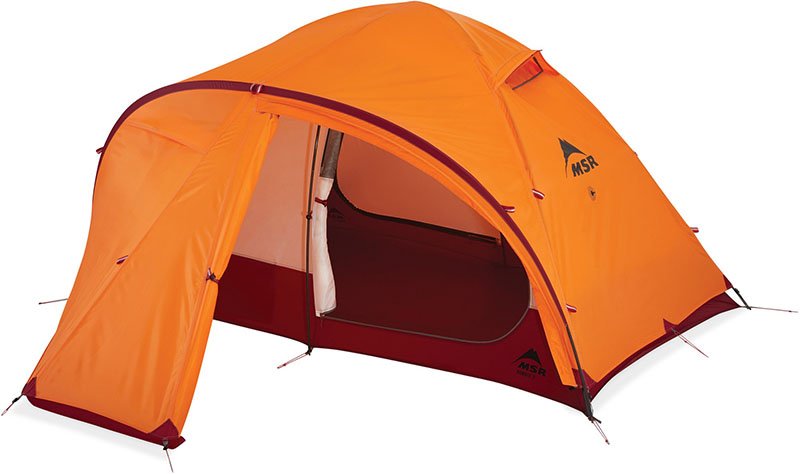
The MSR Remote 2 is a four-season backpacking tent that offers dependable protection and comfort, making it an ideal choice for long stays in rugged alpine or remote terrains – a great tent that will work for summer outings but is also engineered to withstand harsh storms.
It’s nearly effortless to assemble and disassemble, which is invaluable on expeditions or backcountry ski missions.
The roomy interior features make it a great camping tent with a spacious hooped vestibule, with ample storage and cooking space. It’s designed for wet weather and extreme temps, with reinforced attachment points and snow flaps.
The MSR Remote 2 offers less headroom compared to other top backpacking tents and the interior doors are a bit small, but setting up and taking down this tent is a breeze thanks to its intuitive design and secure pole attachments. It performs well in rainy conditions and will keep you dry and comfortable.
The MSR Remote 2 excels as a long-term shelter as its robust construction means it will stick around. While it may not be the lightest option, its performance and reliability make it a compelling choice for mountaineering expeditions, backcountry ski trips, and backpacking adventures.
Specs
- Sleeping Capacity: 2 persons
- Minimum Trail Weight: 6 lbs. 11 oz.
- Packaged Weight: 7 lbs. 2 oz.
- Packed Size: 7 x 20 inches
- Floor Dimensions: 87 x 55 inches
- Peak Height: 44 inches
Best for Ventilation: Sea To Summit Alto TR1 Tent
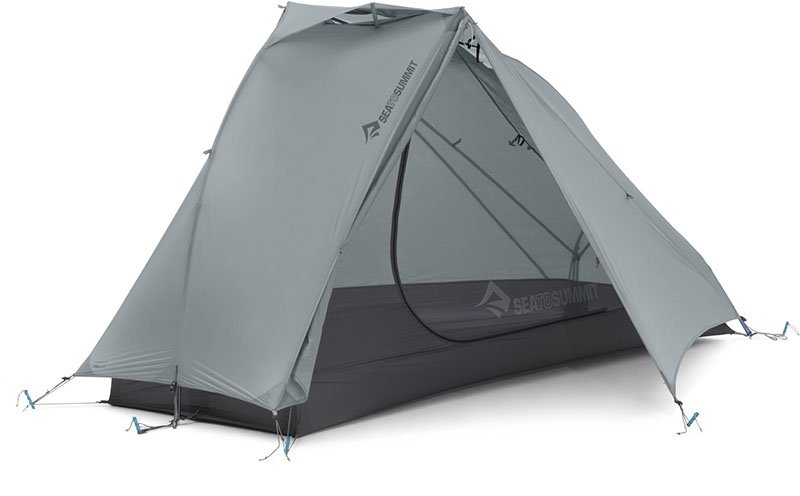
The Sea to Summit Alto Tr1 stands out as a top-notch one-person semi-freestanding double-wall tent, with great airflow. For the solo hiker concerned about trail weight, this is the best ultralight backpacking tent. This is a spacious tent that still manages to be very light, at 2 pounds.
Featuring a single side door and a generously sized vestibule, it provides room for storing gear with easy access. The ventilation is superb, so you can enjoy a cool interior with minimal condensation buildup, even during warm weather or humid conditions.
Although a lighter tent, its interior volume, and near-vertical walls make a unique five-sided inner tent. This configuration means it’s more comfortable to move around than in most backpacking tents. You can change clothes easily and store personal items within arm’s reach.
The inner tent’s abundance of mesh promotes excellent airflow, while a single D-shaped door makes entry and exit swift, with dual zippers for easy access to stored gear. The five-sided floor layout provides additional space for internal gear storage and maximizing headroom.
Equipped with a multi-segment pole and a tension ridge cross pole, the Alto Tr1’s structure is stable. The rainfly, has a split vestibule door, for gear storage and maintaining ventilation. The added top vent regulates airflow between the inner tent and the rainfly, effectively venting warm air to mitigate moisture and condensation.
However, the inability to control the vent from within the inner tent may be slightly inconvenient.
The tent’s top vent lacks screening, potentially inviting insects into the space between the inner tent and rainfly. While this may not always be a significant issue, it warrants consideration, especially during peak insect seasons.
The Sea to Summit Alto Tr1 is a spacious and comfortable one-person tent, offering ease of setup and impressive livability for solo adventurers seeking a reliable and breathable shelter on the trail.
Specs:
- Sleeping Capacity: 1 person
- Minimum Trail Weight: 2 lbs. 1 oz.
- Packaged Weight:2 lbs. 7.2 oz.
- Packed Size:4.3 x 17.7 inches
- Floor Dimensions: 84.5 x 42/24 (L x W head/foot) inches
- Peak Height: 42.5 inches
Best for Comfort: MSR Hubba Hubba 2 Tent
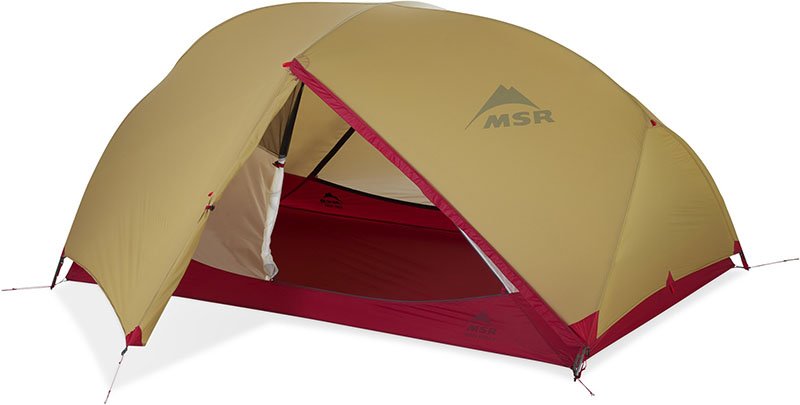
The MSR Hubba Hubba is the best tent for backpackers seeking quality, durability, and comfort. There is no foot taper so you get extra room across the tent. There are overhead pockets and large vestibules.
Its thoughtful design includes composite poles, a waterproof rainfly, and a raised bathtub floor, ensuring solid performance in wet and windy weather.
Although on the smaller side at 15 sq. ft., the vestibule design effectively prevents water from dripping inside when opened. While the latest model has less mesh for ventilation, deployable vents on the rainfly help maintain airflow without compromising waterproofing.
The Hubba Hubba is a great backpacking tent. Setup is straightforward, thanks to its freestanding structure and symmetrical design. Its interior space is generous, and accommodating two people comfortably with plenty of storage options.
Despite its thin 20-denier fabrics, the tent proves durable, with minimal signs of wear over time.
Specs
- Seasons: 3-season
- Sleeping Capacity: 2 persons
- Minimum Trail Weight: 2 lbs. 14 oz.
- Packaged Weight: 3 lbs. 4 oz.
- Packed Size: 4.5 x 19 inches
- Floor Dimensions: 84 x 50 inches
- Peak Height: 40 inches
Best for 1 Person: Six Moon Designs Lunar Solo Tent
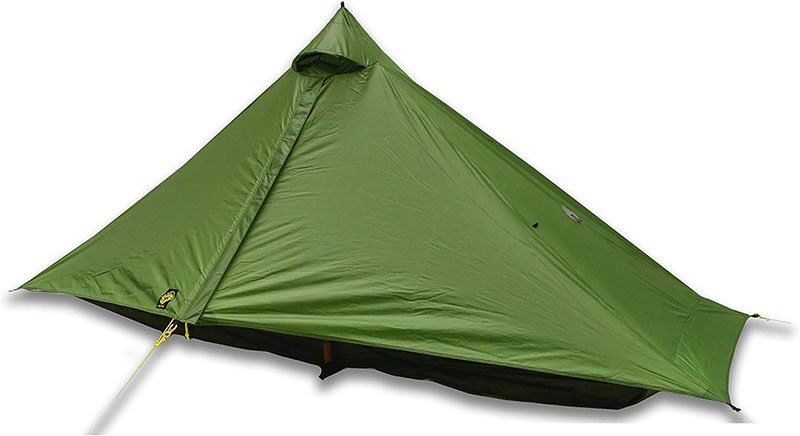
The lightest three season tent on our list, the Six Moon Designs Lunar Solo backpacking tent is the best backpacking tent for solo adventurers seeking a lightweight, durable, and storm-worthy shelter.
It offers enough interior space for your gear inside, plus room for your dog. You can pitch just the tent body in a trail hut.
With excellent storm protection, it’s the best backpacking tent for long-distance thru-hikes who want to save weight wherever possible. With its innovative single-pole support design, the Lunar Solo is easy to set up and take down quickly.
It requires a tent pole to set up, which you can extend all the way to create a very high peak. Many backpacking tents nowadays use this hiking pole option to lessen packed weight.
Featuring a 6-inch bathtub floor and plenty of interior and vestibule space, the Lunar Solo also protects from rain and snow. Made from high-quality silpoly fabric, it’s resilient to tears.
It has a silicone-coated polyester floor and canopy to withstand sharp objects and inclement weather. The innovative floating bathtub floor reduces stress on the tent body and minimizes punctures. While not the most resilient to wind, the adjustable tension cords help in windy conditions.
Its large side entry and oversized screen make it easy to get in and out. The tent’s optimized peak height of 49 inches makes it comfortable for taller hikers.
While it could have larger internal pockets, to save a few extra ounces, this is the ideal tent to add to your outdoor gear.
Overall, the Six Moon Designs Lunar Solo stands out as a top choice for solo backpackers and bike-packers seeking a lightweight, durable, and spacious shelter for their trips.
Specs:
- Seasons: 3-season
- Sleeping Capacity: 1+ persons
- Minimum Trail Weight: 1 lbs. 9 oz.
- Packed Size: 11 X 4.5 inches
- Floor Dimensions: 90 x 48 inches
- Peak Height: 49 inches
Buyer’s Guide: What to Consider When Buying a Backpacking Tent
Double-Wall Versus Single-Wall
Tents with two walls have an inner tent with mesh for ventilation and an outer rainfly for weather protection. They typically offer better ventilation and reduced condensation. However, they may be heavier due to the extra layers.
Single-wall tents combine the inner tent and rainfly into one piece, which reduces weight and simplifies setup. They are more compact and light, making them ideal for ultralight backpacking, but they may be less breathable and prone to condensation buildup.
If you prioritize weight savings and simplicity, a single-wall tent may be the way to go. If you value better weather protection and ventilation, a double-wall tent might be better.
Durability
Tent poles should be made from sturdy materials like aluminum or fiberglass, with high-quality shock cords to maintain tension. Look for poles with thicker diameters, and consider hubs or interconnected segments for more stability in windy conditions.
Opt for durable stakes made from materials like aluminum or titanium, which offer better strength-to-weight ratios than plastic stakes. Consider the design of the stakes, such as Y-shaped or V-shaped, for improved holding power in different types of terrain.
Look for tents with double-stitched seams and sealed seams to prevent water infiltration. Reinforced stress points, such as corners and guy-out loops, add longevity to the tent by reducing wear and tear over time.
Higher denier fabrics are thicker and are more resilient against abrasion and punctures. Ripstop fabrics prevent tears from spreading.
Space to Weight Ratio
Think about every ounce you’ll be carrying on your back. Look for tents made with lightweight materials like Silnylon or Dyneema, and consider sacrificing a bit of space for a significant weight reduction.
Look for tents with ample room but minimal weight and a small packed size so it doesn’t take up your entire backpack.
Set-Up
Ease of setup can make a huge difference at the end of a long day on the trail.
Look for tents with color-coded poles, clips instead of sleeves for attaching the tent body to the poles, and simple, freestanding designs that don’t require precise staking, like non-freestanding tents which may be limited in where they can be pitched.
However, non-freestanding tents are often lighter and more compact, making them preferred for ultralight backpacking where every ounce counts.
Weather Protection
Weather protection means more than just having a rainfly. Check the hydrostatic head rating (waterproofness) of the tent’s fabric and seams, and look for features like bathtub floors and reinforced guy-out points for added protection against wind and rain.
Storage
Size isn’t just about how many people the tent can fit; it’s also about the interior space for gear storage and comfort. Think about whether you need extra vestibule space for your backpacks and boots, or if you want to go for a snugger fit to minimize weight.
Frequently Asked Questions
What type of tent is best for backpacking?
Many backpackers prefer lightweight and compact tents. Generally, freestanding or semi-freestanding tents with double-wall construction are popular choices for their versatility and comfort. They are easier to use across seasons, where you may not want a tent fly, and are very fast to set up.
A footprint serves as a protective layer between the tent floor and the ground, providing additional durability and waterproofing.
If you’re planning to backpack in rocky terrain or areas with sharp objects like twigs or thorns, a footprint can provide crucial protection against punctures and abrasions, potentially saving your tent floor from damage.
In wet or rainy conditions, a footprint adds an extra layer of waterproofing, preventing moisture from seeping through the tent floor and keeping you dry and comfortable throughout the night.
On the other hand, if you’re embarking on an ultralight backpacking trip where every ounce matters, skipping the footprint can help reduce pack weight without sacrificing much in terms of durability or waterproofing, especially if you’re camping on softer ground like grass or sand.
What is packaged weight vs. minimum trail weight?
Packaged weight includes all components of the product, like stuff sacks and stakes, while minimum trail weight refers only to the essential components needed for setup, such as the tent body, poles, and rainfly.
What is the ideal weight for a backpacking tent?
Generally speaking, a tent should weigh approximately 2.5 pounds per person. You may wish to use a heavier tent in certain situations. Heavier tents often come at a lower price point compared to ultralight models. If budget is an issue consideration, you can prioritize price over weight savings.
If you’re setting up camp in one location for an extended period, such as during a multi-day camping trip or expedition, the weight of the tent becomes less of a concern since you won’t be carrying it every day on your back.
In environments with extreme weather conditions, a heavier tent will be more robust against the weather.
How much should a 1-person or 2-person backpacking tent weigh?
A 1-person backpacking tent typically weighs between two to four pounds, with ultralight options often weighing under two pounds.
A good weight for a 2-person backpacking tent is typically between three to six pounds. Ultralight options may weigh closer to three pounds or even less, while more durable or feature-rich models may weigh closer to six pounds.
Is 4 lbs, 5 lbs, or 6 lbs too heavy for a backpacking tent?
Four pounds may be considered heavy for a backpacking tent, especially for those aiming for ultralight or lightweight setups. For shorter trips or less physically demanding terrain, a four-pound tent may be fine if it offers other desirable features like spaciousness, durability, or better weather resistance.
However, if you’re planning long-distance hikes or aiming to minimize pack weight, you may want to explore lighter tent options to reduce the overall burden on your back.
The Best Backpacking Tents
Choosing the best backpacking tent can be difficult when there are hundreds of options out there, but finding the right tent for your trip is easy when you know what you’re looking for.
Looking at how big of a living space each tent has, how easy it is to set up, and whether it’s better against harsh weather and high heavy (or light) it is, can help you decide.
You also want to make sure that you can sustain carrying your tent on your back for long distances if you are going to be backpacking for extended periods, so always check the weight.
Our top pick for the best all-around backpacking tent is the REI Half Dome SL 2+. This backpacking tent is a workhorse that comes at a great price.
It may not have all the flashy features of some of the higher-end tents, but it has everything you need, is durable, and more spacious than many other lightweight tents, and will be your trusted shelter for the long haul.
But no matter whether you’re just remote camping or spending months on the trail, you can’t go wrong with one of our picks for the best backpacking tents.
For more options, check out our picks for the best ultra-light tents.







